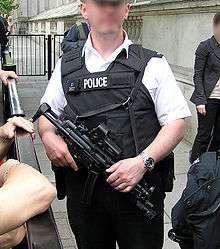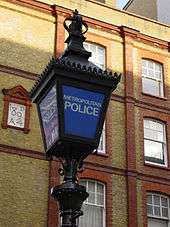Parliamentary and Diplomatic Protection
Parliamentary and Diplomatic Protection (PaDP) is a branch of Protection Command within the Specialist Operations directorate of London's Metropolitan Police Service.[1] It was formed in April 2015, with the merger of the Diplomatic Protection Group (SO6) and the Palace of Westminster Division (SO17). Due to its responsibilities, PaDP is an armed command, with most of its officers being Authorised Firearms Officers.
.jpg)
Role
PaDP is responsible for:
- Protection of government owned buildings and embassies.
- Residential protection for high-profile ministers, visiting heads of state, heads of government and foreign ministers.
- Counter-reconnaissance at events identified as high risk, diplomatic functions or key sites.
- Searching and access control of visitors and vehicles to New Scotland Yard and Downing Street
- Assisting with protection at buildings such as the Palace of Westminster
- Counter-terrorism activities with other police units, both armed and unarmed
The primary responsibility of PaDP is the safety and security of London's diplomatic/governmental communities and parliamentary estate. The unit provides protection for foreign missions in London, such as embassies, high commissions, consular sections and official residencies in accordance with Article 22 of the Vienna Convention. PaDP also provide protection and keep order on the Parliamentary Estate to ensure both the House of Commons and House of Lords can conduct their business without disruption.
PaDP protect the diplomatic community in London, providing residential protection for Her Majesty's Government, former prime ministers, government ministers, visiting foreign government ministers and heads of state and anyone else deemed to be high risk. They also provide protection at high-profile buildings such as New Scotland Yard and where necessary PaDP will provide armed protection at hospitals for patients at threat as well as hospital staff.
PaDP also provide the physical security of the Palace of Westminster working closely with the House Authorities, particularly the Serjeant-at-Arms (House of Commons) and Black Rod (House of Lords) to provide around the clock security every day of the year. Officers patrol the building and its grounds and control access of people and vehicles onto the Estate. There is a dedicated search wing, trained to conduct counter-terrorism searches.
History
PaDP was created in April 2015, via the merger of the Diplomatic Protection Group (DPG, SO6) and the Palace of Westminster Division (SO17).
When the Diplomatic Protection Group was formed in November 1974, it was a branch of A division which policed Westminster, due to most diplomatic premises being within the area.[2] DPG officers have provided armed security for The Queen Mother, as well as security for the funeral of Diana, Princess of Wales. In addition, DPG residential protection officers have provided armed protection to many world leaders during visits to London.[2]
The Palace of Westminster Division (SO17) was a branch of the Specialist Operations Directorate within London's Metropolitan Police Service. SO17 was responsible for security at the Palace of Westminster, as well as for the rest of the Parliamentary Estate.[3] Officers of SO17 were unarmed, with armed security being provided by the Diplomatic Protection Group (SO6).
Notable incidents

During the Iranian Embassy siege, Police Constable (PC) Trevor Lock was on protection duty. He was taken hostage along with the embassy staff and managed to conceal his firearm until the assault by the British Army's Special Air Service, when he then restrained the terrorist leader.[2]
Other incidents where DPG officers have used firearms include when PC Peter Slimon GM visited the National Westminster Bank on Kensington High Street on 27 December 1972 to draw money out while on his lunch break:[4] he found that a bank robbery was in progress, fatally wounded one of the robbers, and injured two other robbers. In the same incident, PS Stephen Peet responded, and shot the third robber. PC Gordon McKinnon was authorised to free a hostage in Trafalgar Square, and did so.
Another notable incident was the September 2012 Plebgate scandal, involving officers guarding Downing Street.
On 22 March 2017, during the 2017 Westminster attack, PC Keith Palmer, 48, of the PaDP was stabbed to death in New Palace Yard whilst guarding the Palace of Westminster.[5] A Foreign Office minister, Tobias Ellwood, tried unsuccessfully to resuscitate PC Palmer, who later succumbed of his injuries.[6]
On 3 June 2017 PaDP officers responded to the Borough Market and London Bridge terror attacks. Off duty PaDP officers PC Liam Jones BEM and PC Stewart Henderson BEM rendered first aid to seriously injured members of the public before protecting 150+ people and evacuating them by the Metropolitan marine support unit (MSU) and RNLI Boats to the north shore of the Thames.
Equipment
Firearms routinely carried by DPG officers include the Glock 17 and Heckler & Koch MP5. Officers are also equipped with bulletproof vests and the non-lethal Taser X2. Like every other British police officer, they carry a telescopic baton, speedcuffs, CS spray, soon to be replaced with PAVA spray, and a Motorola radio, soon to be replaced with a SEPURA radio.
The Vauxhall Vivaro is used to transport large numbers of officers. The Vauxhall Zafira is used by supervisors, however these are being phased out and replaced by the newer Ford C-Max.
References
- "Parliamentary and Diplomatic Protection". Metropolitan Police Service. Archived from the original on 26 January 2017. Retrieved 7 November 2016.CS1 maint: unfit url (link)
- "History of the Diplomatic Protection Group". Metropolitan Police Service. Archived from the original on 5 May 2016. Retrieved 26 February 2016.CS1 maint: unfit url (link)
- "SO17 Palace of Westminster". Metropolitan Police Service. Archived from the original on 5 August 2016. Retrieved 3 May 2013.CS1 maint: unfit url (link)
- "Period 1946 to date". Friends of the Metropolitan Police Historical Collection. Archived from the original on 2012-02-15.
- "London attack: What we know so far". BBC News. Retrieved 23 March 2017.
- "'Hero' MP Tobias Ellwood tried to save stabbed officer". BBC News. Retrieved 23 March 2017.
